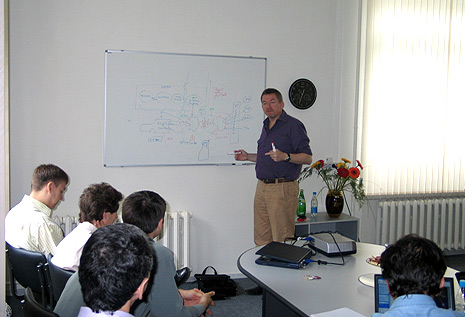 |
Articles
30 Mar 2021 Pivot Points In the Story of LEDASAlexey Ershov
It’s just before our 22nd anniversary on April 1, and looking back at the history of LEDAS, I see that the first years from each decade were, for our company, the really important ones. Often, these years started new stories and finalized old ones.
Arguably, 2011 was the most pivotal year in LEDAS’ history. Let me list the top five events that happened to our company ten years ago:
- Top management changed completely when co-founder David Levin stepped back as CEO and took on the role of Chairman of the Board. A new generation of young managers, aged around 30 years old, now occupied the CEO, CTO, and COO positions.
- Thanks to advice from an industry mate, LEDAS decided to focus mostly on high-quality software R&D (research and development) services for the global engineering market, instead of paying equal attention to those services and the development of our own component CAD products.
- We sold the exclusive IP rights to most of our products, including, most notably, our LEDAS Geometric Solver to the Menhirs-Bricsys group of companies. This was a significant win-win deal, especially when taking into consideration that by focusing on services we greatly increased our earnings the next decade.
- LEDAS had just stepped into a new arena, CAM (computer-aided manufacturing), through a new cooperation with one of the leaders in sheet metal & composite CAM software. This was an important step that took CAM and additive manufacturing to the #1 position in LEDAS’ earnings a decade later.
- The 10+ years of mutually beneficial collaboration with Dassault Systѐmes had concluded; it was our greatest source of income in the 2000s.

David Levin and Bricsys CEO Erik de Keyser are signing the agreement on the acquisition, October 2011, Gent, Belgium
A decade earlier, 2001 is also a good contender for the title of “The Year of Most Important Changes.” We experienced events like these ones:
- Only two years after founding LEDAS as an offspring of a laboratory of artificial intelligence, our firm hit a brick wall with the NASDAQ dot-com nightmare, losing our primary investor in the USA.
- This pushed us to move away from general, AI-related, in-house R&D projects we had been developing back then. These included a real and integer constraint propagation solver, a scheduler that worked with fuzzy data, and a rule-based engine. Instead, we moved into the world of CAD (computer-aided design).
- We started the first CAD project of our own, LEDAS Geometric Solver (LGS), which, in the years that followed, became for us the most influential product.
- An early version of LGS inspired Dassault Systѐmes to expand our existing academic cooperation with them into a technical one, which resulted in LEDAS developing several key components for CATIA, including a new constraint solver.

< Dominique FLORACK, Senior Executive Vice President, Products, Strategy – R&D, in the LEDAS offices, 2004
Changes To LEDAS’ Expertise In 2001, 2011, 2021
It can be interesting to compare how we positioned ourselves twenty years ago, ten years ago, and now.
Twenty years ago, we prefered to describe LEDAS as having the abilities in the following areas:
- Constraint propagation and interval math
- Under-defined models with discrete and continuous variables
- NP-hard (nondeterministic polynomial) problems and quasi-optimal methods for solving them
- Symbolic and numerical methods of non-linear system solving
- Heuristic search
This clearly is an academic list, employing scientific terms like “NP-hard.” At the time, this was natural, because we had not yet really “met the market.” Our proposals were shaped mostly on the basis of our previous experience in academia. Meeting the market was at that time our most important goal.
Ten years ago, we were an established company, known to the international B2B (business to business) CAD market. These are what we considered in 2011 to be our primary areas of expertise:
- 2D and 3D geometric constraint solvers
- Collision detectors
- Motion simulators
- Direct modelers
- Computational geometric engines
The list looks much more technical. We already had our LGS geometric constraint solver recognized by the global market. We had also completed several high-tech R&D projects for respectable customers, such as Dassault Systѐmes, Cimatron, Bricsys, and other LGS licensees. But our areas of expertise were niches, and not the broad fields with which potential customers could engage us.
Today, LEDAS identifies six primary areas of expertise:
These are big sectors of the contemporary engineering software market. Adopting these areas helped us increase our team by several times. By having this portfolio, we entered US market successfully, which is now the #1 market for LEDAS, as well as expanded our customer bases in Asia, Europe, and Russia.
We continue to broaden our knowledge and skills in those fields, providing customers with state-of-the-art methods, architecture, tools, processes, and solutions. But, maybe, adding even more areas of expertise could be even more interesting, and beneficial.
We have not, of course, forgotten our former specialties. Knowledge we gained from previous fields of expertise are included into the new ones. For instance, we used methods of non-linear system solving in the mid-2000s when we built our geometric constraint solvers, and then we used those solvers for projects in BIM, CAD, and 3D Web applications in the mid-2010s. Thanks to our early academic background, our expertise is not just wide, it is also deep.
In 2021, we will do our best to meet the new demands of the global market in engineering software R&D, and so turn this year into another key marker in our history!
See also:
Permanent link :: http://isicad.net/articles.php?article_num=21781

|
 |